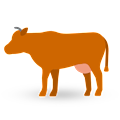Leg
In English butchery, leg refers to the section of beef derived from the hindquarters of the animal. Positioned towards the rear, it encompasses both the upper and lower parts of the animal's back leg. As it originates from a portion of the cow that is regularly exercised, leg contains well-developed muscles with moderate fat and connective tissue.
Meat from the leg tends to be leaner and denser than some other cuts due to the regular activity of this muscle group. However, this exercise also imbues the leg with a pronounced beefy flavor, making it particularly robust in taste. Different portions of the leg can be utilized in varied ways.
The upper part, which is meatier and slightly more tender, can be roasted as a joint or cut into steaks. The lower portion, being tougher, benefits from slow-cooking methods like braising or stewing. Read more
In English cuisine, cuts from the leg might be found in dishes ranging from traditional roasts to slow-cooked casseroles. For roasting, it's essential to season well and use techniques that lock in moisture, such as basting or marinating beforehand.
Given its lean nature, leg cuts can dry out if overcooked. When using the tougher parts for stews or braises, extended cooking at a low temperature will break down the meat's connective tissues, resulting in a tender and flavorful dish. The robust flavor of the leg pairs well with hearty accompaniments.
Root vegetables, robust herbs like rosemary and thyme, and rich sauces or gravies complement leg cuts. For slow-cooked dishes, red wine, beef broth, or tomato-based sauces can enhance its depth of flavor.

